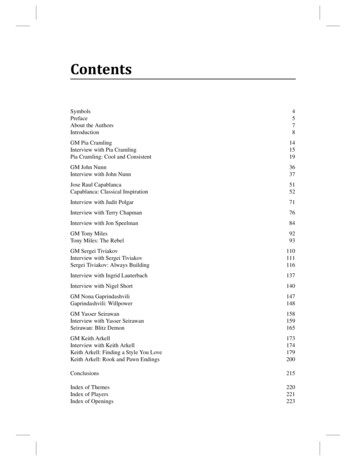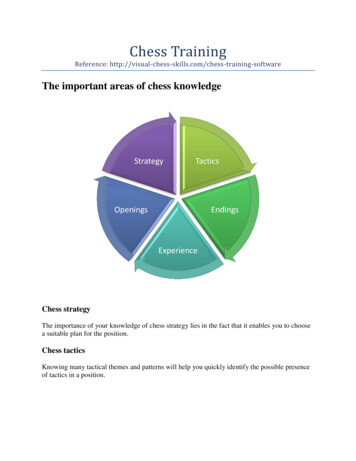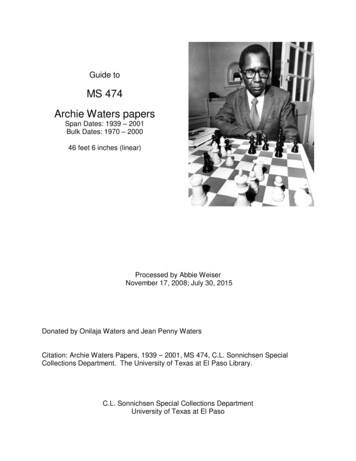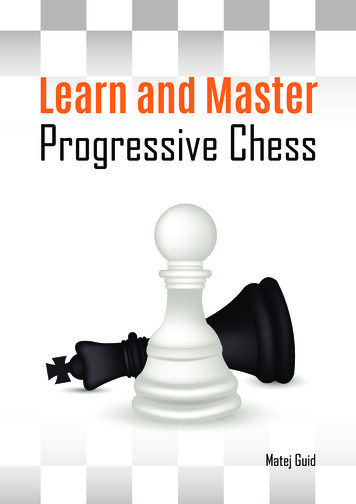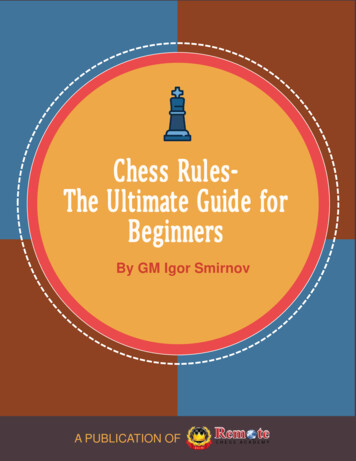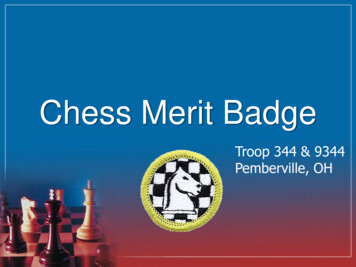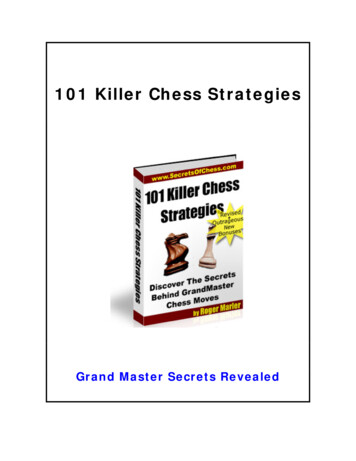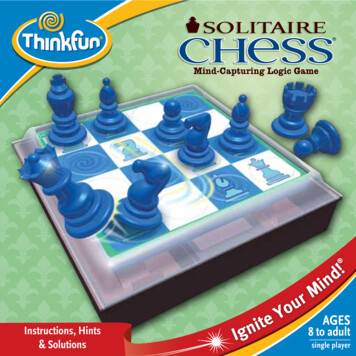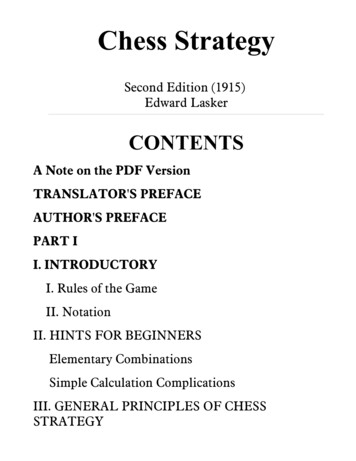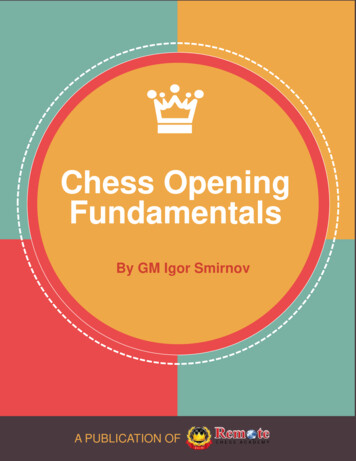
Transcription
JOURNEY THROUGH CHESSPART 1A CHESS COURSE FOR CHILDRENbased on the chessKIDS academy website (www.chesskids.org.uk)The official chess course of Richmond Junior Chess ClubRICHARD JAMES1
IntroductionFirst, a bit of background. I’ve been teaching chess for forty years. It became apparent to me some years ago thatmost children in this country were not getting a good experience of chess. So I stopped most of my chess teaching,studied child development and looked at the very different experiences that children received in other countries.If you just want to treat chess as a parlour game, teach your children the moves, then go ahead and play. They’ll getsome benefit just as they will from playing any other board game, but they won’t become good players. If you’rereading this now I’m assuming, and hoping, that you want your children to take chess seriously, either because youwant them to have the opportunity to become serious competitive players should they wish to do so, or because ofthe unique educational benefits that chess, if it’s taught correctly, has to offer.Whereas here in the UK children are taught the moves at home so that they can join a chess club, in other countrieschildren join a chess club so that they can be taught correctly right from the start. Very often children learn the movesslowly, taking a year or more to learn all the moves, while at the same time learning how to look at a chess board, andunderstanding the underlying logic of the game. Without these skills, children will do little more than play randommoves.My belief is that there are, for most children, few advantages and many disadvantages in starting chess very young.Most children enjoy board games, but many of them would be better off playing simpler games with fewer optionsand only moving onto chess when they are ready. Playing chess, even at a low level, involves the sort of logical skillsthat children typically develop around the age of 7 or 8, and playing competitive chess involves the more complexskills that children typically develop around the age of 11 or 12. Many children who learn the moves at 7 or 8 startwell, but get stuck after 18 months or so, get frustrated because they’re not making progress and eventually give up.Some exceptional children, under exceptional circumstances, can develop the appropriate skills earlier, sometimes,much earlier.It seems there are two approaches you could take if you want your children to learn chess. (If you’re reading this youprobably do want your children to learn, and so you should, because, in my opinion, chess is the best game in theworld.) If you want your children to develop naturally it’s best to start at about 9 or 10, so that, after a couple of years,when they need more complex thinking skills to improve, those skills are available to them. If, however, you want touse chess as a learning tool, and use the game as a means of accelerating your children’s cognitive development, thenyou could start at 7 or 8. In principle, older children will pick up the fundamental logic of the game much more quicklythan younger children, and will be less likely to get ‘stuck’ when things become too hard for them.The younger children start, the more help they will need from their parents. We recommend that chess should betreated in the same way as learning a musical instrument, with, at first, 10 or 15 minutes practice a day. This willinvolve solving puzzles and playing games, and, at least at first, children will need a lot of support from their parents toensure that they have mastered each concept before moving on to the next one. As complex thinking skills are besttaught with a few pieces we introduce the different men one at a time, gradually increasing the complexity of thepositions and tasks. Playing once a week at the school chess club and doing nothing in between is arguably worse thanuseless.If you’re reading this in the UK or in the United States, you might find these methods strange, but they are very muchstandard across much of Europe, from the Netherlands to Russia. I believe this is the right way for your children tolearn chess.Before you start, it will help very much if you have a copy of The Right Way to Teach Kids Chess (Right Way Books) andaccess to the course website. Your children will also enjoy reading Chess for Kids (Right Way Books). You will also needa full size Staunton Pattern chess set and a board with the coordinates (a-h, 1-8) on the side.2
CHAPTER 1THE CHESS BOARDWe start by introducing the chess board. Demonstrate that there are 8 squares on each side alternating light and dark:64 squares in total.The light squares are sometimes known as ‘white’ squares and the dark squares ‘black’ regardless of the actual colour.Ensure (it’s important that this is reinforced every lesson) that there’s a white square in your right hand corner. Wealways start with the white pieces on the ranks numbered 1 and 2 and the black pieces on the ranks numbered 7 and8.We call the vertical rows ‘files’ and the horizontal rows ‘ranks’.Here we see some ranks, files and diagonals.3
Young children often have problems following straight lines on the chessboard, especially diagonals. Get your childrento demonstrate these lines to you by moving a finger or a piece along them, from beginning to end.Now explain that the each file has a letter and each square a number. We talk about, for instance, the b-file or the efile. (Ranks are a bit more confusing as we often refer to them from the perspective of the player: so White’s seventhrank is numbered 7 but Black’s seventh rank is numbered 2. But when naming squares they’re always numbered as onthe diagram.)Each square has a name comprising the letter of the file followed by the number of the rank. In this position thesquares a1, b5, e4 and h6 have been indicated.The following worksheets give children the opportunity to find and identify squares. They can also practise thisinteractively at .Most children of this age will have little difficulty with this task but if it’s a problem you could leave it and return to itlater.A great way to make sure that children have really understood the concept is to ask them to set some puzzlesthemselves. If you can do some, perhaps make some (deliberate) mistakes, and get your children to mark them, you’llhave more idea as to whether or not the lesson has been absorbed.If children are familiar with the names of the squares it makes it much easier to talk about a game. It also opens upthe whole world of chess literature. This specific lesson also teaches children about the concept of squares andstraight lines, about the use of coordinates, and starts to teach them how to use the symbolic language of chessnotation.If you like, you can introduce the pieces at this point, but there’s no need to do so. The danger is that children mightwant to play complete games before they’re ready.4
5
6
CHAPTER 2THE PAWNIdentify the pawns in the chess set and count how many there are of each colour. The pawns are the footsoldiers inthe army. Demonstrate where they start, then get your children to do the same thing.Explain that the eight white pawns start on the rank numbered 2 and the eight black pawns on the rank numbered 7.The pawns move one square forward. On their first move, however, they can choose between moving one or twosquares forward. (Note: this means on the pawn’s first move, not just on the first move of the game.)Unlike other pieces, pawns do not capture in the same way that they move. Instead they capture one squarediagonally forwards. When making a capture you remove the enemy piece from the board and replace it with yourpiece. You don’t jump over as in draughts (checkers). Young children sometimes find this physically difficult and endup with the captured piece somewhere on the board. Practise this with your children until they get used to it.In this position the white pawn on e2 can move to either e3 or e4. The black pawn on d6 can only move to d5. Thepawns on g4 and g5 are stuck: they cannot move at all.7
Practise the pawn moves until you are confident that you remember and understand them, and that you can correctlymake captures with your pawn finishing on the correct square and the enemy pawn being removed from the board.The next three pages of worksheets are designed to reinforce knowledge of the pawn move. They should not causeany problems to anyone who has mastered the pawn move.Children can use arrows to indicate the move, or, if they prefer, write down the name of the square to which they aremoving. It’s not a bad idea to encourage use of notation for children who are old enough to do this easily.Note that we write a move down (in this volume we’re using the long version of standard chess notation) using a dash(-) to separate the starting and finishing squares of the move. If the move is a capture we replace the ‘-‘ with ‘x’.8
9
10
11
Now we’re going to play some games.In games of chess the players take it in turns to move a piece, with White making the first move.Some games are games of luck: winning or losing depends on the throw of a dice or the drawing of a card. Somegames are partly games of luck and partly games of skill. Other games are games of pure skill. The most skilful player,the player who makes the best decisions and plays the best moves will win.Chess is a game of pure skill. This is why it’s not enough just to know how the pieces move. In any position there maybe some moves that win, some moves that draw and some moves that lose. To be a good player you have to knowwhy some moves are better than others, and learn how to make good decisions when you make a move.We’re going to play some games under the rules we call CAPTURE THE FLAG. Chess is a war game: a battle betweentwo armies, the white army and the black army. The chessboard is the battlefield. Imagine that there’s a flag at theother end of the board. The first player to capture the flag wins.In CAPTURE THE FLAG games with pawns there are three ways to win:1) You win the game by getting a pawn to the other end of the board before your opponent (to CAPTURE THEFLAG)2) You win the game by capturing all your opponent’s pieces3) You win the game if it’s your opponent’s move and he/she cannot make any legal move.We start by playing very simple games with one pawn each. If you’re given the choice would you play White or Black?Why? Can you describe the strategy you’d use to win the game? Young children will very often give an illogicalresponse to questions like this, based on emotion or impulse rather than stopping to think and work out which moveswould be best.You can play these games online against a computer at By playing these games children are learning important lessons: how to use logic rather than emotion to makedecisions; how to control your impulses: how to make predictions; how to look ahead and work out what’s going tohappen next; the importance of assuming your opponent’s going to play the best move, rather than the move youwant him/her to make. All these skills are vital: reinforce and praise at every opportunity. Look at how you can usethese skills away from the chessboard.When you’ve mastered these games you can move onto games with two pawns: you can take on the computer tm, or, better still, play against a human.12
Next, you can try games in which one player starts with more pawns, for example:You should find these positions easy for the player with the extra pawn to win. This brings us to the underlyingprinciple of chess: that SUPERIOR FORCE (usually) WINS.This means (for the moment) three things: in principle you should take a free pawn if you can, if your opponent istrying to take a pawn for nothing you should do something about it, and you should avoid playing moves that giveyour opponent a free pawn (unless you’ve looked ahead and worked out that you can win by doing so).These three principles: ATTACK, DEFENCE and SAFETY underpin everything that follows in this course.We can now move onto the complete CAPTURE THE FLAG pawn game. If you’re an experienced player you might wantto start by giving odds to your children. (If you’re a beginner and your children are picking it up more quickly than youthey might want to give you odds!) If you like you can challenge the computer htm.13
There are two strategies you can use to win a complete CAPTURE THE FLAG pawn game.The first strategy is to run your opponent out of good moves and reach a position where he/she can only play movesthat lose a pawn. Very often you will be in a position towards the end of the game where you have a choice betweenmaking an exchange and advancing a pawn. One will win and one will lose – but you have to look ahead. It’s usually(but not always) correct to advance in this situation, but children will be tempted to exchange because they like theidea of taking an enemy piece and hope they won’t get taken back.The second strategy is to use asymmetric exchanges to create a PASSED PAWN. A passed pawn is a pawn which is freeto reach the end of the board without being blocked or captured by an enemy pawn. If you have a passed pawn youshould advance it at every opportunity. (When you’re ready to play a full game of chess you’ll find that passed pawnsare often very useful there as well.)Our next set of worksheets reinforces the skills you need to play the pawn CAPTURE THE FLAG game successfully.When solving these it’s a good idea, especially for younger children, to set the pieces up and play through the moveson the board together with your children to work out the answer rather than just expecting them to solve the puzzlesfrom the diagrams.First we have to find moves which offer a pawn exchange. Many children are very wary of playing moves which offeran exchange because they don’t want to lose one of their pieces. Because young children have difficulty seeingsituations from someone else’s perspective, or perhaps because they’re not looking ahead, they are very reluctant toplay a move which loses something, even if they get something else in return. You will see that in some of thesequestions the exchange will create a passed pawn – can you identify which questions these are?On the other hand, many children are driven by their lack of impulse control to play a move before they’ve checkedwhether or not it’s safe – whether or not their opponent will be able to take it for nothing. You have to train yourselfto stop and check that the move you’ve thought of is safe before playing it, just as you have to check that it’s safebefore you cross the road.Before you do the next sheet, it will help if you learn more about notation: how to write down your move. In this partof the course we use long algebraic (standard) notation. When we move a pawn we write the starting square, then adash/minus sign (-), then the finishing square, for instance a2-a4. For a capture we use a multiplication/times sign (x)instead of the dash: for instance e6xd7. In real chess, when we get a pawn to the end we can choose to exchange itfor a knight, a bishop, a rook or a queen. At the moment we’re in effect choosing a queen so when we reach the endwe add a Q after the move: for instance g7-g8Q. This might be too hard for younger children: if so, you can skip it anduse arrows, and help them with the notation on the following page.Finally, an exercise in decision making. You’re given two moves: your job is to decide which of those two moves you’dplay. At one level you can consider chess to be the art of decision making. Here, the first part of the job, consideringyour options, has been done for you. You just have to make the choice, which you do by looking ahead. Thinking inthis way is alien to many young children, which is why they often find this type of task very difficult. Younger childrenwill need your help, along with a set and board, for this. Consider, too, when you have to make decisions in real life.Give your children a choice and ask them what they think would happen next with each option.14
15
16
17
18
There’s one more pawn move that needs to be learnt at some point: the EN PASSANT capture.Many young children find this difficult to understand so it doesn’t matter too much if they don’t get it first time, butthey will need to know it before joining a chess club.The EN PASSANT capture works like this: you have a pawn on your fifth rank (number 5 for White, number 4 forBlack). Your opponent moves a pawn on the next file two squares, so that it finishes up alongside your pawn. You maythen, on your next move and ONLY on your next move, capture it as if it had moved just one square.Observe the diagrams below.In the first diagram it’s Black’s move. He chooses to move his pawn two squares. The second diagram shows theposition after this move. White now chooses to capture this pawn EN PASSANT (while it’s passing the d6 square). Thethird diagram shows the position after the EN PASSANT capture. White’s pawn is now on d6 and the black pawn hasbeen removed from the board.Once your children understand the idea, you might want to reinforce it on a regular basis to ensure they remember it.It doesn’t come up very often but knowing or not knowing it can make the difference between winning and losing thegame.If your children have problems with any particular type of question, feel free to set them some more questions untilthey understand. If something’s really too hard you can always come back to it later.Encourage your children to set some puzzles for you to solve. If you like, make some mistakes and see if they notice.This will ensure that they really understand the concept behind each page.Continue to play Capture the Flag pawn games with your children until you feel they’re ready to move on. Somechildren may be ready more or less straight away. Other children might be happy playing these games for weeks oreven months. This is absolutely fine. There’s no hurry, especially for younger children. If you wait too long it doesn’tmatter: they’ll soon catch up. But if you introduce something too soon you could put them off for life.19
CHAPTER 3THE ROOKFind the rooks in your chess set and set them up for the start of the game as in the diagram below. Note that thecorrect name is ROOK, not castle. Many casual players still call it a castle but if you do so in a chess club or tournamentyou’ll be laughed out of court. The name comes from a Persian word for ‘chariot’ and they were originally the chariotsin the army. In many Western European countries they’re known as the tower. Ensure that you use the correct nameyourself (you might occasionally call it a castle to see if your children notice) and that your children also use thecorrect name.Ensure that your children can identify the rooks and place them on their correct starting squares.The rook can move horizontally or vertically as many squares as it likes, as in the diagram on the left:Unlike the pawn, but like all other pieces, it captures the same way that it moves. It can capture an enemy piece in itspath and is blocked by a friendly piece in its path. It cannot jump over other pieces or capture more than one piece ata time. In the diagram on the right the rook can capture either black pawn.20
Now we know about rooks and pawns we can move onto the important subject of attacking and defending.First, some definitions to avoid confusion.If we move a piece to a square where it could take another piece next move it’s an ATTACK.If we move a piece to a square where it WANTS TO take another piece next move it’s a THREAT.Rooks are, self-evidently, more valuable than pawns. We assign a value of 1 point to a pawn and a value of 5 points toa rook. Children need to learn, memorise and understand the significance of this.If we have a piece which is protecting our piece so that we can take back if an enemy piece takes it, this is aDEFENDER.If we attack an enemy piece which is not defended this is a THREAT. If our opponent THREATENS one of our pieces wecan do several things:a)b)c)d)we can move it to a safe squarewe can defend it with another piecewe can capture the attacking piecewe can block the attack by putting a piece in the wayIf we attack a more valuable piece (a rook) with a less valuable piece it’s automatically a THREAT, even if the morevaluable piece is defended. We should be very happy to lose a pawn (or two) if we get a rook in exchange. Youngchildren often have problems with this concept: they will say that they don’t want to lose their pawn even if they havethe chance to capture a rook. If your children have a problem with this you need to reinforce it at every opportunity.On the other hand we don’t want to win a pawn (or two) if we’re going to lose a rook in the process. So, if an enemypawn threatens our rook we need to move out of the way, but if an enemy rook threatens our pawn we’d probably behappy to defend it.Even better than threatening one piece is threatening two pieces. If your opponent meets one threat you may still beable to carry out the other threat and win a piece by doing so.The next set of worksheets deals with the ideas of creating threats and defending pieces which are threatened.Children who have understood the rook move and the concepts of attack and defence will not find these difficult. Afew younger children might struggle with moving rooks along straight lines: if so provide more practice in making rookmoves across or up and down the board. These worksheets are also designed to improve chessboard vision and teachthe geometry of chess. You might like to point out that a rook can threaten an enemy pawn in two ways: consider thatthe rook and the pawn are on opposite corners of a rectangle: the rook can threaten the pawn by moving to either ofthe other two corners.21
22
23
24
25
Before we move onto some games with rooks, we’re going to make a slight modification to the CAPTURE THE FLAGrules.If you get a pawn to the end of the board you PROMOTE it into another piece: in rook games we use a queen. Youropponent then has one move in which to capture the queen if he can. You win the game by playing a move with thepromoted piece. (Note: the queen moves like a rook, and also diagonally.)We’re going to start by playing some games in which a rook battles against an army of pawns. With young children,you might start by getting them to use a rook to stop one pawn. You’ll see that this is easy: the rook can win byoccupying the same file as the enemy pawn and then capturing it next move. If, on the other hand, you threaten thepawn along the rank, the pawn will just advance. Another winning strategy, though, is to place the rook along the nextrank to the enemy pawn, so that you can capture it when it advances.Then continue adding pawns, moving on when your children are confident, until you reach rook against five pawns:for instance the diagram below.You can win this game with White as long as you give a bit of thought to each move. It’s a good idea to start by movingRh1-h7 (note that we add a capital R at the front when recording rook moves) which threatens, directly or indirectly,all the black pawns.White’s strategy should be to capture as many black pawns as possible, as long as it’s safe to do so, while watching tosee if an enemy pawn is approaching the end of the board.You can play rook against four, five or six pawns against the computer tm. If you want to take the side of the pawns instead (and it’sgood to play all these games from both sides) click on the You Start button: the computer will turn the board roundand make a move. The computer doesn’t play the rook very well, though, so you may well be able to win with thepawns.Encourage your children to make up their own games as well. How far advanced do two pawns have to be to winagainst a rook? What about three pawns? Or four pawns? Making up new games and puzzles based on what theyalready know is a great way to encourage your children’s creativity as well as reinforcing their knowledge.26
Our next worksheets look at captures, exchanges and safety within the context of rooks and pawns.The first set of questions invites the student to capture pawns safely: in other words without losing your rook. Allplayers need to look for captures every move and check every move they play is safe.Then we consider trading pieces: will an exchange be good, equal or bad? For the purposes of this and similarworksheets, an exchange of pieces of equal value (here, rook for rook or pawn for pawn) is considered an equalexchange, an exchange of a weaker piece for a stronger enemy piece is considered a good capture, and an exchangeof a stronger piece for a weaker enemy piece is considered a bad capture. In some of the positions you have twopieces that can capture the same enemy piece so you have to look further ahead and count all the points once all thecaptures have been exhausted. (Remember: pawn 1 point, rook 5 points.)The next sheet again focuses on safety: is the indicated move safe? If you play that move, will your opponent be ableto win points by capturing it? Again, don’t forget to look for recaptures on the same square.Finally, some positions where you have to make a decision between two moves. You’ll probably need to set up theboard and work through both moves in order to solve these puzzles successfully.If your children are having difficulties with any of these question types you could make up your own questions to givethem more practice. Again, you could ask them to set their own questions if you like.27
28
29
30
31
Our Capture the Flag rook games give you the opportunity to practise rook moves, and also to learn the beststrategies for using rooks. These will come in useful once you start to play complete games of chess.Start if you like with just one rook each. If your children are lacking confidence, you could start without your rook orwithout a few of your pawns. Alternatively you could start with two rooks against one.The best strategy for using rooks is to place them on OPEN FILES. An OPEN FILE is a file with no pawns on it. If a filehas an enemy pawn but not one of your pawns it’s a HALF-OPEN FILE. These can also be good for rooks.Play through these moves from the position on your left (note how we use move numbers): 1. e2-e4 e7-e6 2. d2-d4d7-d5 3. e4xd5 e6xd5 (a symmetrical pawn exchange) 4. Ra1-e1. White already has a winning advantage: next movehe will play Re1-e7, attacking a lot of black pawns.Now play these moves again from the position on your right. Black has to challenge White on the open file by movingone of his rooks to e8. If White trades rooks he will be in trouble so he needs to maintain the tension.You can play some of these games against the computer at m.You will see that the computer keeps score of the game (on the right of your screen). You can print off the moves andgo through them with your children. Did they play any moves that lost pieces? Was it because they didn’t see thecomputer’s threat or because they played an unsafe move? In some ways rook captures are easier to ‘see’ than pawncaptures, because they capture the same way as they move, but they can also be harder to see because they happenover long distances.If your children are enjoying these games you can carry on playing them. Younger children may be happy to stop herefor a few months, but older children, once they’ve mastered the rook move, learnt to ‘see’ rook moves and captures,and understood the strategy, will be keen to move onto the next piece, the bishop.32
CHAPTER 4THE BISHOPFind the bishops in your chess set and set them up for the start of the game as in the diagram below. The shape of thepiece represents the bishop’s headdress (mitre). The bishops were originally the elephants in the Indian army.Ensure that your children can identify the bishops and place them on their correct starting squares.The bishop can move diagonally as many squares as it likes, as in the diagram on the left:Like the rook, it captures the same way that it moves. It can capture an enemy piece in its path and is blocked by afriendly piece in its path. It cannot jump over other pieces or capture more than one piece at a time. In the diagram onthe right the bishop can capture either black pawn.Ask your children to play some bishop moves on the board. Many young children find it difficult to follow diagonals. Ifthis is a problem give them more opportunity to practise this before continuing.33
We now know about three pieces: the pawn, the rook and the bishop. It’s important to understand that some piecesare more powerful than others so that we know when we should trade pieces off and when we should keep pieces onthe board.Ask your children which piece they think is stronger: the rook or the bishop. Make sure they give a reason for theirchoice.It should be clear that a rook is more powerful than a bishop. A good answer would be that in some positions it can goto more squares. The best answer would be that a bishop can only visit half the squares on the board. Demonstratethat a bishop starting on a white square can never reach a black square. Demonstrate also that a rook in the corner ofan empty board has 14 possible moves while a bishop in the same corner has only 7 moves. In the centre, a rook stillhas 14 moves and a bishop 13 moves.So we have a hierarchy of pieces. It’s helpful for beginners to assign values to each piece. Typically, and very crudely,the pieces we’ve learnt so far have these values (slightly undervaluing the bishop and over valuing the rook):Pawn: 1 pointBishop: 3 pointsRook: 5 pointsEmphasize that it’s
Now we’re going to play some games. In games of chess the players take it in turns to move a piece, with White making the first move. Some games are games of luck: winning or losing depends on the throw of a dice or the drawing of a card. Some games are partly games of luck and pa
